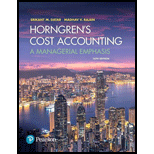
Horngren's Cost Accounting: A Managerial Emphasis (16th Edition)
16th Edition
ISBN: 9780134475585
Author: Srikant M. Datar, Madhav V. Rajan
Publisher: PEARSON
expand_more
expand_more
format_list_bulleted
Question
Chapter 22, Problem 22.27P
A.
To determine
Transfer Pricing:
This refers to a process of pricing in which one sub-unit of an organization charges a price to another sub-unit for supplying a product or service to the sub-unit of the same organization.
To determine: Whether transfers should be made in division B if there is no unused capacity in division A and whether the market price is the correct transfer price.
B.
To determine
Whether the 800 units should be transferred to division A and at what transfer price.
C.
To determine
The contribution to the company as a whole if the transfer were made and as a manager whether buying can be done at $110.
D.
To determine
The transfer price that would produce the same operating income for division A for the two options (a) cutting the external price to $156, with the certainty that the sale will rise to 2,000 units and (b) maintaining the external price of $160 for the 1,200 units and transferring the 800 units to division B at a price that would produce the same operating income.
Expert Solution & Answer
Trending nowThis is a popular solution!

Students have asked these similar questions
general accounting
A company has net income of $ 1,390,000. It also has
179,000 weighted-average common shares outstanding
and a market value per share of $169. The company's
price-earnings ratio is equal to:
Solve this questions
Chapter 22 Solutions
Horngren's Cost Accounting: A Managerial Emphasis (16th Edition)
Ch. 22 - Prob. 22.1QCh. 22 - Describe three criteria you would use to evaluate...Ch. 22 - What is the relationship among motivation, goal...Ch. 22 - Name three benefits and two costs of...Ch. 22 - Organizations typically adopt a consistent...Ch. 22 - Transfer pricing is confined to profit centers. Do...Ch. 22 - What are the three methods for determining...Ch. 22 - What properties should transfer-pricing systems...Ch. 22 - All transfer-pricing methods give the same...Ch. 22 - Prob. 22.10Q
Ch. 22 - Prob. 22.11QCh. 22 - Prob. 22.12QCh. 22 - Prob. 22.13QCh. 22 - Under the general guideline for transfer pricing,...Ch. 22 - How should managers consider income tax issues...Ch. 22 - Evaluating management control systems, balanced...Ch. 22 - Cost centers, profit centers, decentralization,...Ch. 22 - Prob. 22.18ECh. 22 - Prob. 22.19ECh. 22 - Multinational transfer pricing, effect of...Ch. 22 - Prob. 22.21ECh. 22 - Multinational transfer pricing, global tax...Ch. 22 - Prob. 22.23ECh. 22 - Prob. 22.24ECh. 22 - Transfer-pricing problem (continuation of 22-24)....Ch. 22 - Prob. 22.26PCh. 22 - Prob. 22.27PCh. 22 - Effect of alternative transfer-pricing methods on...Ch. 22 - Goal-congruence problems with cost-plus...Ch. 22 - Multinational transfer pricing, global tax...Ch. 22 - Transfer pricing, external market, goal...Ch. 22 - Prob. 22.32PCh. 22 - Transfer pricing, goal congruence, ethics. Cocoa...Ch. 22 - Prob. 22.34PCh. 22 - Transfer pricing, perfect and imperfect markets....Ch. 22 - Prob. 22.36PCh. 22 - Prob. 22.37P
Knowledge Booster
Similar questions
- Please explain the solution to this financial accounting problem with accurate principles.arrow_forwardHow many units must be sold to earn income of $60,000?arrow_forwardDuring July, the first month of the fiscal year, sales totaled $900,000 and the cost of merchandise available for sale totaled $800,000. Estimate the cost of the merchandise inventory as of July 31, based on an estimated gross profit rate of 40%.arrow_forward
- Solve this financial accounting problemarrow_forwardArdent Manufacturing purchased a machine for $140,000. It is estimated that the machine has a useful life of 5 years and will be sold for $10,000 at the end of its useful life. Using the straight-line method, the carrying value of the machine at the end of the fourth year of the machine's useful life is_____.arrow_forwardWhat is the amount of the gross profit ?arrow_forward
arrow_back_ios
SEE MORE QUESTIONS
arrow_forward_ios
Recommended textbooks for you
 Managerial AccountingAccountingISBN:9781337912020Author:Carl Warren, Ph.d. Cma William B. TaylerPublisher:South-Western College Pub
Managerial AccountingAccountingISBN:9781337912020Author:Carl Warren, Ph.d. Cma William B. TaylerPublisher:South-Western College Pub Financial And Managerial AccountingAccountingISBN:9781337902663Author:WARREN, Carl S.Publisher:Cengage Learning,Principles of Accounting Volume 2AccountingISBN:9781947172609Author:OpenStaxPublisher:OpenStax College
Financial And Managerial AccountingAccountingISBN:9781337902663Author:WARREN, Carl S.Publisher:Cengage Learning,Principles of Accounting Volume 2AccountingISBN:9781947172609Author:OpenStaxPublisher:OpenStax College Managerial Accounting: The Cornerstone of Busines...AccountingISBN:9781337115773Author:Maryanne M. Mowen, Don R. Hansen, Dan L. HeitgerPublisher:Cengage Learning
Managerial Accounting: The Cornerstone of Busines...AccountingISBN:9781337115773Author:Maryanne M. Mowen, Don R. Hansen, Dan L. HeitgerPublisher:Cengage Learning

Managerial Accounting
Accounting
ISBN:9781337912020
Author:Carl Warren, Ph.d. Cma William B. Tayler
Publisher:South-Western College Pub

Financial And Managerial Accounting
Accounting
ISBN:9781337902663
Author:WARREN, Carl S.
Publisher:Cengage Learning,

Principles of Accounting Volume 2
Accounting
ISBN:9781947172609
Author:OpenStax
Publisher:OpenStax College

Managerial Accounting: The Cornerstone of Busines...
Accounting
ISBN:9781337115773
Author:Maryanne M. Mowen, Don R. Hansen, Dan L. Heitger
Publisher:Cengage Learning